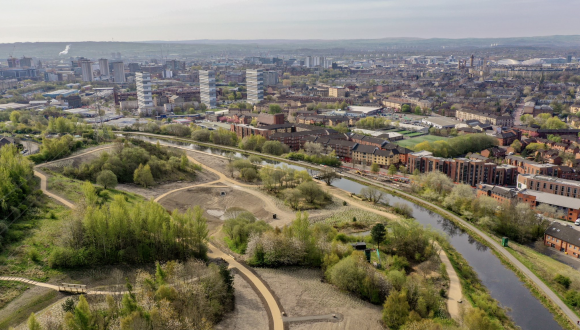Green Infrastructure in Scotland, delivering nature-based solutions
Scotland’s Green Infrastructure Strategic Intervention (GISI) creates better places and enhances quality of life in some of Scotland’s most deprived areas. It does this by improving the green infrastructure in major towns and cities.
Green Infrastructure in Scotland, delivering nature-based solutions
Scotland’s Green Infrastructure Strategic Intervention (GISI) creates better places and enhances quality of life in some of Scotland’s most deprived areas. It does this by improving the green infrastructure in major towns and cities.
It’s an ambitious project by any measure. The overall budget includes around £15m from the European Regional Development Fund (ERDF), which was specifically set up in 1975 to address pressing social and economic imbalances within and between regions of the EU.
In the case of GISI the ERDF monies are split over two phases, amounting to an overall investment of around £40m, which is in turn split between two work streams of 15 capital and 11 community engagement projects. Funding was distributed after fiercely competitive application rounds, and winning applications were selected on the basis of clear ability to deliver across the funds’ five outcomes:
- Nature, biodiversity and ecosystems
- Environmental quality, flooding and climate change
- Involving communities and increasing participation
- Increasing place attractiveness and competitiveness
- Improving health and wellbeing
This is the first time that there has been an intervention at this scale to fund nature-based solutions to address social inequality, in this case through the creation of quality green infrastructure in Scotland.
Creating excellent greenspace in areas which suffer from multiple deprivation and an excess of vacant and derelict land can be challenging. However, the rewards are considerable.
Communities benefit hugely from successful multifunctional spaces. These can address inequalities, provide opportunities for better health, support sustainable economic growth and create space for nature. Bold ambition, partnership working and a mixture of powerful drivers lie at the heart of this work.
The list of benefits above will be familiar to anyone who has been advocating greater movement towards providing nature-based solutions (NBS).
With so many positive outcomes Scotland’s Green Infrastructure Fund has proved popular. Extremely popular. The number of applications to the fund has grown with each application round, with the most recent round being significantly over-subscribed.
As for delivering projects of this ambitious scope it isn’t a surprise to learn that this hasn’t been without issue. There are understandably stringent controls surrounding ERDF monies, both in their use and eligibility, and the sheer administrative burden required for claiming and reporting has limited the pool of applicants who can access the funding. Within the two-tier nature of the project (larger capital projects and smaller community engagement projects) it is perhaps no surprise that the ‘smaller’ category can find the capacity needed to fulfil reporting and record-keeping particularly demanding.
The successful projects have to prove more than their own individual worth. They must aim to contribute to solutions which address a mixture of problems in specific areas. Thus as well as tackling needs on a project by project basis, they need to demonstrate an ability to complement and ‘dove-tail’ into wider ambitions in their given area.
One project that has come through the process and recently completed is Greater Easterhouse, an area once synonymous with significant social problems. Green Infrastructure will not solve all its problems in an instant, but it provides a valuable stepping stone on the road to recovery.
Up to 40% of funding for projects can be provided by GISI (this rises to 70% in the Highlands and Islands). Match funding comes from the public and charitable sectors. That’s an approach which has two benefits. It helps promote the aims of GI and NBS themes through encouraging increased investment whilst simultaneously demonstrating multiple benefits to a wider audience.
NatureScot is the lead government agency on GISI north of the border and a dedicated team of seven staff run the GIF and GICEF. They are tasked with ensuring that the successful projects not only succeed in their own right but visibly contribute to mainstreaming GI and influencing future policy, planning and funding decisions.
Seven current projects will be the standard bearers for those that follow (you can read about them on the Green Infrastructure web site). They are based in the Glasgow and Aberdeen area and a consistent quality is their multi-functionality. Their work will make a real difference to local people’s lives, increase communities’ engagement with green infrastructure and build awareness and understanding of the benefits of this kind of work to others.
Of course all good projects want to leave a long term legacy. So what about the future?
It won’t come as a surprise that it is an ERDF requirement that projects are monitored beyond their initial implementation. The window of monitoring lasts until 2030. There is sound logic in this approach. ERDF does not fund on-going maintenance and management, so it is a condition of GIF funding that the grantees demonstrate they have plans in place to ensure their site is managed and maintained until at least 2030, and that the site will continue to be used for the approved purposes.
Delivering nature-based solutions has never been more important. Scotland’s Green Infrastructure Fund Strategic Intervention offers a vital avenue to ensure these aspirations reach fruition.
AT A GLANCE:
- Around £15m ERDF committed to 15 capital and 11 community engagement projects
- 7 capital projects and 11 community engagement projects due to complete in 2020.
- A further 8 capital projects due to start in 2020.
- Influencing and facilitating knowledge transfer and demonstrating the wider benefits of Green Infrastructure.







